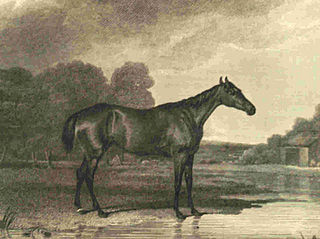
The 1810s was a decade of the Gregorian calendar that began on January 1, 1810, and ended on December 31, 1819.
USS Ranger may refer to the following ships of the United States Navy:

HMS Minden was a Royal Navy 74-gun Ganges-class third-rate ship of the line, launched on 19 June 1810 from Bombay, India. She was named after the German town Minden and the Battle of Minden of 1759, a decisive victory of British and Prussian forces over France in the Seven Years' War. The town is about 75 km away from Hanover, from where the House of Hanover comes—the dynasty which ruled the United Kingdom from 1714 until 1901.

HMS Tonnant was an 80-gun ship of the line of the Royal Navy. She had previously been Tonnant of the French Navy and the lead ship of the Tonnant class. The British captured her in August 1793 during the Siege of Toulon but the French recaptured her when the siege was broken in December. Rear-Admiral Horatio Nelson captured her at Aboukir Bay off the coast of Egypt at the Battle of the Nile on 1 August 1798. She was taken into British service as HMS Tonnant. She went on to fight at the Battle of Trafalgar in 1805, during the Napoleonic Wars.

Robert Goodloe Harper, was an American politician and a federalist. He was a member of the United States Senate from Maryland, serving from January 1816 until his resignation in December of the same year. He also served in the South Carolina House of Representatives (1790–1795), the U.S. House of Representatives from South Carolina (1795–1801), and in the Maryland State Senate. He is best remembered for the phrase, "Millions for defense, but not one cent for tribute" in connection with the XYZ Affair. The town of Harper, Liberia, is named after him.

HMS Starr was a 16-gun Merlin-class ship sloop of the Royal Navy. She was built by Tanner, of Dartmouth, to plans by Sir William Rule, and launched in July 1805. As a sloop she served on convoy duty, though she also participated in the invasion of Martinique in early 1809. She was rebuilt as a bomb vessel in May 1812 and renamed Meteor. As Meteor she served in the Baltic and then off the United States, participating in attacks on up the Potomac and on Baltimore and New Orleans. She was sold in October 1816.

Chasseur was a Baltimore Clipper commanded by Captains Pearl Durkee, William Wade (1813) and Thomas Boyle (1814-1815). She was one of the best equipped and crewed American privateers during the War of 1812.

HMS Saturn was a 74-gun third-rate ship of the line of the Royal Navy, launched on 22 November 1786 at Northam. The vessel served during the Napoleonic Wars with the Channel Fleet, taking part in the 1801 Battle of Copenhagen. With the beginning of the War of 1812, Saturn was modified to become a frigate designed to take on large American vessels of that type. Saturn was deployed as part of the blockading squadron of New York City from 1814 to 1815. From 1825, the vessel was in harbour service and was broken up in 1868.

Éole was a Téméraire class 74-gun ship of the line of the French Navy.

HMS Recruit was an 18-gun Cruizer-class brig-sloop of the Royal Navy, launched in 1806 at Sandwich, Kent. She is best known for an act of pique by Commander Warwick Lake, who marooned a seaman, and for an inconclusive but hard-fought ship action under Commander Charles John Napier against the French corvette Diligente. She captured a number of American vessels as prizes during the War of 1812 before being laid up in 1815 and sold for breaking up in 1822.
HMS Shelburne was the American letter of marque schooner Racer, built in Baltimore in 1811 and captured by the British in 1813. She served on the American coast, capturing the American brig Frolic. She also captured some merchantmen and was sold in Britain in 1817.
HMS Whiting, built in 1811 by Thomas Kemp as a Baltimore pilot schooner, was launched as Arrow. On 8 May 1812 a British navy vessel seized her under Orders in Council, for trading with the French. The Royal Navy re-fitted her and then took her into service under the name HMS Whiting. In 1816, after four years service, Whiting was sent to patrol the Irish Sea for smugglers. She grounded on the Doom Bar. When the tide rose, she became flooded and was deemed impossible to refloat.

Minuet (1812–1833) was a British Thoroughbred racehorse and broodmare who won the classic Oaks Stakes at Epsom Downs Racecourse in 1815. In a racing career which lasted from July 1814 until October 1817 she competed twenty-one times, winning nine races and being placed on a further ten occasions. On her only race in 1814, she won the July Stakes, one of the year's most important races for two-year-olds. In the following year she finished second in the 1000 Guineas on her debut and then won her next three races including the Oaks. Minuet stayed in training for two further seasons, winning five more races including a victory over a strong field in the all-aged Trial Stakes in September 1816. After her retirement from racing she had some success as a broodmare, breeding several winners.
Charlotte was a British Thoroughbred racehorse and broodmare who won the inaugural running of the classic 1000 Guineas at Newmarket Racecourse in 1814. The Guineas was Charlotte's only race as a three-year-old but she returned to run four times in 1814. She won a Gold Cup at Stamford but was retired after being injured in a race at the same course a day later.

Medora (1811–1835) was a British Thoroughbred racehorse and broodmare who won the classic Oaks Stakes at Epsom Downs Racecourse in 1814. In a racing career which lasted from April 1814 to May 1816, she ran thirteen times, won four races, and twice "received forfeit" when her opponent did not appear for a scheduled match race. Unraced as a two-year-old, Medora produced her best form in the first half of 1814, she finished third in the inaugural 1000 Guineas, won the Oaks and then claimed two races at Royal Ascot. She remained in training for two more seasons but was less successful, winning only one competitive race. She was retired to stud where she became a highly successful and influential broodmare, whose direct descendants won many major races throughout the 19th and 20th centuries.
HMS Canso was the American letter of marque schooner Lottery, launched in 1811, that a British squadron captured in 1813. The Royal Navy took Lottery into service as HMS Canso and she served during the War of 1812 and briefly thereafter. The navy sold her in 1816.
HMS Childers was a Royal Navy 18-gun Cruizer-class brig-sloop that Nicholas Diddams built at Portsmouth Dockyard and launched in 1812. She was broken up in 1822.

Comet, an American schooner, was built in 1810 at Baltimore, Maryland. She was owned by "a group of wealthy Baltimore investors." Under Captain Thomas Boyle, who was a part owner of the schooner, Comet sailed from July 1812 to March 1814 as a privateer, which was a type of ships licensed by the United States during the War of 1812 to harass the British merchant vessels and divest their cargoes.
Zephyr was a vessel built in the United States that the Royal Navy captured in late 1813. Between 1814 and 1840, when she was lost, she made eight voyages as a whaler in the southern whale fishery.











